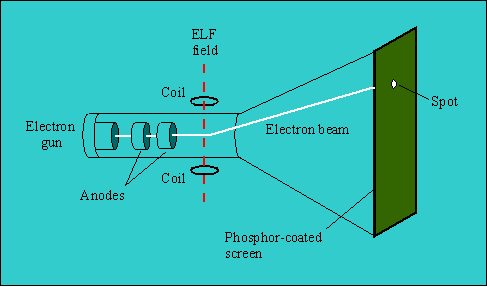cathode ray tube (CRT)
What is a cathode-ray tube?
A cathode-ray tube (CRT) is a specialized vacuum tube in which images are produced when an electron beam strikes a phosphorescent surface. Most desktop computer displays make use of CRTs. The CRT in a computer display is similar to the "picture tube" in a television receiver.
A cathode-ray tube consists of several basic components, as illustrated below. The electron gun generates an arrow beam of electrons. The anodes accelerate the electrons. Deflecting coils produce an extremely low frequency electromagnetic field that allows for constant adjustment of the direction of the electron beam. There are two sets of deflecting coils: horizontal and vertical.(In the illustration, only one set of coils is shown for simplicity.) The intensity of the beam can be varied. The electron beam produces a tiny, bright visible spot when it strikes the phosphor-coated screen.

To produce an image on the screen, complex signals are applied to the deflecting coils, and also to the apparatus that controls the intensity of the electron beam. This causes the spot to race across the screen from right to left, and from top to bottom, in a sequence of horizontal lines called the raster. As viewed from the front of the CRT, the spot moves in a pattern similar to the way your eyes move when you read a single-column page of text. But the scanning takes place at such a rapid rate that your eye sees a constant image over the entire screen.
The illustration shows only one electron gun. This is typical of a monochrome, or single-color, CRT. However, virtually all CRTs today render color images. These devices have three electron guns, one for the primary color red, one for the primary color green, and one for the primary color blue. The CRT thus produces three overlapping images: one in red (R), one in green (G), and one in blue (B). This is the so-called RGB color model.
In computer systems, there are several display modes, or sets of specifications according to which the CRT operates. The most common specification for CRT displays is known as SVGA (Super Video Graphics Array). Notebook computers typically use liquid crystal display. The technology for these displays is much different than that for CRTs.